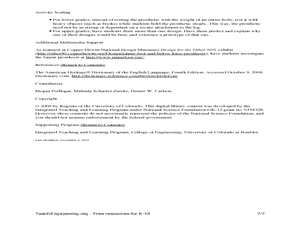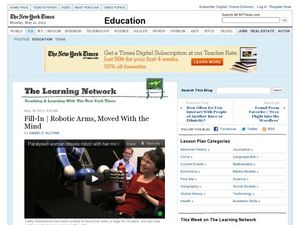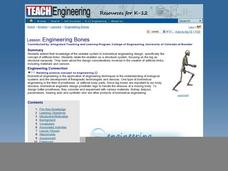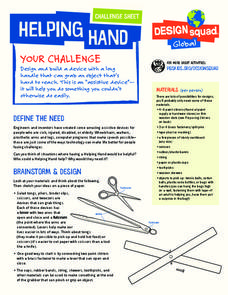Purdue University
Model of Prosthetic Leg
Give the class a leg up in their understanding of engineering. A STEM activity has learners design a prosthetic leg that can kick a ball. They build a prototype of the prosthetic, keeping track of the design costs associated with their...
Curated OER
Prosthetic Party
Students examine human anatomy by creating a prosthetic limb. In this medical engineering lesson, students view numerous images of prosthetics used in science today and define several medical terms associated with prosthetics....
Curated OER
Build a Prosthetic Device
Seventh graders become familiar with biomedical engineering. For this prosthetic device lesson, 7th graders consider the needs of a prosthetic device to help a specific person's characteristics. Students build a prosthetic...
Curated OER
Brain-Controlled Robotic Arms: Cloze activity with Article
Fascinating content about current medical research on brain-controlled prosthetics comes in cloze activity form with a link to the original article. Useful for listening and reading comprehension skills development, and for any science...
Curated OER
Prosthetic Design
Students research characteristics of different body parts. Students design and sketch a prosthetic they developed. They share their idea with the class and complete a worksheet.
Community Resources for Science
Spring Mechanics
Scholars practice calculating spring constants before performing hands-on experiments. They compare data for parallel and series springs. Finally, they learn how spring mechanics find applications in biotechnology, such as prosthetic limbs.
Curated OER
Engineering Bones
Pupils identify the features of a prosthetic limb and explain how engineers are involved in the prosthetic design. For this bone engineering lesson students describe the design criteria that goes into choosing the materials that go...
Curated OER
Human Biotechnology
The human organism is the subject of this PowerPoint. It recaps some of the major facts about human genome, systems, life processes, and different progressions that have been made in science and medicine through the years.
Curated OER
How To Make an Artificial Organ
Young scholars examine the advances made in technology with regard to prosthetics and replacement organs and limbs. They describe the anatomy and functions of different organs and create their own artificial organ. They defend and...
Curated OER
How to Make an Artificial Organ
Students design bionic organs or limbs. In this medical technology lesson, students view a video about artificial organs and prosthetic limbs. They research the medical technology behind these advances and work to design a organ or limb...
Curated OER
No Valve in Vain
Students design and create their own heart valves out of a variety of materials. Their heart valves are one way valves designed for water flowing through a tube representing blood moving through the heart.
Curated OER
Extending Human Ability Through Technology
Middle schoolers explore how technology has been used to enhance human abilities. Using the internet, they watch a short video about prosthetics. They compare and contrast how prosthetics have changed over the years as technology has...
PBS
Helping Hand
Reach out and grab something. Given the task of picking up objects at least two feet away, pupils design and build a grabber. The last activity in a series of five challenges requires learners to use information about fulcrums and levers.
Rochester Institute of Technology
Biomechanical Joint
Discuss mechanical advantage and how the human body moves/works. Learners focus on bioengineering, working together to build a functioning mechanical arm. Additionally, they analyze an air muscle, discussing its appropriate use in...
DiscoverE
A Leg to Stand On
Give your learners a leg up in their study of engineering. Groups design and create a prothestic for a leg. They test out their designs for strength, stability, durability, and comfort.
Teach Engineering
Tissue Mechanics
Engage your class by showing them how silly putty and human tissues are alike. Pupils learn more about tissue mechanics by reflecting upon their experiences with silly putty. The lesson covers collagen, elastin, and...
Curated OER
Lead and Mercury Ion Catalase Inhibition
Students participate in a laboratory investigation in which they observe the effect of temperature and pH on enzyme activity. Students also examine exposure to heavy metal ions and the effect that may have on enzyme activity.
Curated OER
Silly Semi-Solids
Students create a polymer out of glue, water, and borax. They discuss the resulting substance and perform several experiments with it.
DiscoverE
Helping Hand
Sometimes we all need a helping hand. Scholars get together to lend a hand in creating an assistive device that must be able to grab a hard-to-reach object. Now that's some help we could all use!
Curated OER
Digestion Simulation
Students study the human digestion system and the functions of the stomach and small intestines. In this digestion instructional activity students view a demonstration on the process.
Curated OER
Properties of Matter (Biomaterial Through Nanotechnology)
Students investigate friction between different surfaces. In this physics lesson plan, students research biomaterials that can reduce friction. They calculate efficiency using a mathematical formula.
Curated OER
Muscles, Oh My!
Pupils explore the human muscular system. For this science lesson, students discuss how engineering is related to the field of bio-mechanics and human movement.
Curated OER
Help, I can't reach it!
Students learn the major organ systems in the human body and research simple machines on the Internet; They design an informational brochure about a medical profession and present that career topic to the class.
Curated OER
Strong as the Weakest Link
Students discover the types of stress that materials undergo. They examine how bridges and skyscrapers are built to withhold the tension. They create their own structure out of marshmallows and spaghetti.

























